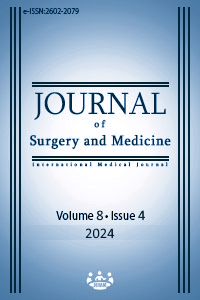The effect of ketofol anesthesia on intraocular pressure in pediatric strabismus surgery
Ketofol and intraocular pressure
Keywords:
induction of anesthesia, intraocular pressure, ketamine, ketofol, propofolAbstract
Background/Aim: Keeping intraocular pressure (IOP) within normal limits is an important goal in the anesthetic management of pediatric strabismus surgery. While propofol is commonly used as an induction agent since it provides smooth laryngeal mask insertion, it has the undesirable side effect of dose-dependent cardiorespiratory depression. On the other hand, ketamine acts as a sympathetic cardiorespiratory stimulant; however, its effect on IOP is controversial. The aim of this study was to determine the effect of the combination of ketamine and propofol (ketofol) on IOP in pediatric strabismus surgery compared to propofol alone.
Methods: Participants included patients aged between 2 and 18 years who underwent strabismus surgery. They were divided into two groups according to type of anesthesia induction: propofol and ketofol. Patient characteristics, surgical data, hemodynamic parameters, oculocardiac reflex (OCR), and IOP were compared between the two groups.
Results: Forty-five children with a mean age of 7.7 years were enrolled in the study. The patients were assigned into two groups: propofol alone (n=26) and ketofol (n=19). The groups were similar in patient characteristics, surgical data, and hemodynamic parameters (P<0.05 for each). IOP was measured at four points: before anesthesia, at 1 minute following induction, at 3 minutes following laryngeal mask airway (LMA) insertion, and at the end of surgery. All IOP values were within normal limits. No significant differences in mean IOP values were found between the groups (P>0.05 for each). There was also no significant difference in OCR between the groups (P=1.000).
Conclusions: Compared to propofol alone, ketofol had a similar effect on IOP, OCR, and hemodynamic parameters. These results suggest that ketofol can be safely used in the induction of anesthesia in pediatric patients undergoing strabismus surgery.
Downloads
References
Wadia S, Bhola R, Lorenz D, Padmanabhan P, Gross J, Stevenson M. Ketamine and intraocular pressure in children. Ann Emerg Med. 2014;64:385-8.e1. DOI: https://doi.org/10.1016/j.annemergmed.2014.01.029
Sahin A, Tüfek A, Cingü AK, Caça I, Tokgöz O, Balsak S. The effect of I-gel ™ airway on intraocular pressure in pediatric patients who received sevoflurane or desflurane during strabismus surgery. Paediatr Anaesth. 2012;22:772-5. DOI: https://doi.org/10.1111/j.1460-9592.2012.03854.x
Eftekhari J, Haki BK, Tizro P, Alizadeh V. A comparison to facilitate insertion of the laryngeal mask: term of recovery and postoperative nausea and vomiting after anesthesia with propofol-atracurium and thiopentalatracurium. Acta Med Iran. 2015;53:117–21.
Seyedhejazi M, Eydi M, Ghojazadeh M, Nejati A, Ghabili K, Golzari SE, et al. Propofol for laryngeal mask airway insertion in children: effect of two different doses. Saudi J Anaesth. 2013;7:266-9. DOI: https://doi.org/10.4103/1658-354X.115339
Becker R, Schmidt W, Viehl H, Rupp D. Supplementierungsmedikamente beim Einsatz der Larynxmaske in der Kataraktchirurgie [Drugs for supplementation in cataract surgery with a laryngeal mask]. Ophthalmologe. 2002;99:752-5. German. DOI: https://doi.org/10.1007/s00347-002-0655-4
Yousef GT, Elsayed KM. A clinical comparison of ketofol (ketamine and propofol admixture) versus propofol as an induction agent on quality of laryngeal mask airway insertion and hemodynamic stability in children. Anesth Essays Res. 2013;7:194. DOI: https://doi.org/10.4103/0259-1162.118957
Oh JN, Lee SY, Lee JH, Choi SR, Chin YJ. Effect of ketamine and midazolam on oculocardiac reflex in pediatric strabismus surgery. Korean J Anesthesiol. 2013;64:500-4. DOI: https://doi.org/10.4097/kjae.2013.64.6.500
Nagalakshmi P, Leo S, Uthirapathi S. Use of butorphanol, fentanyl, and ketamine as co-induction agents with propofol for laryngeal mask airway insertion: A comparative study. Anesth Essays Res. 2018;12:729-34. DOI: https://doi.org/10.4103/aer.AER_104_18
Aberra B, Aregawi A, Teklay G, Tasew H. Effect of ketofol versus propofol as an induction agent on ease of laryngeal mask airway insertion conditions and hemodynamic stability in pediatrics: an observational prospective cohort study. BMC Anesthesiol. 2019;19:41. DOI: https://doi.org/10.1186/s12871-019-0711-0
Halstead SM, Deakyne SJ, Bajaj L, Enzenauer R, Roosevelt GE. The effect of ketamine on intraocular pressure in pediatric patients during procedural sedation. Acad Emerg Med. 2012;19:1145-50. DOI: https://doi.org/10.1111/j.1553-2712.2012.01450.x
Aydoğan MS, Demirel S, Erdoğan MA, Fırat P, Çolak C, Durmuş M. Effects of Ketamine-Propofol Mixture on Intraocular Pressure and Haemodynamics in Elderly Patients: A Randomised Double-Blind Trial. Turk J Anaesthesiol Reanim. 2014;42:12-8. DOI: https://doi.org/10.5152/TJAR.2013.56
Chang CY, Chien YJ, Wu MY. Attenuation of increased intraocular pressure with propofol anesthesia: A systematic review with meta-analysis and trial sequential analysis. J Adv Res. 2020;24:223-8. DOI: https://doi.org/10.1016/j.jare.2020.02.008
Artru AA, Momota Y. Trabecular outflow facility and formation rate of aqueous humor during anesthesia with sevoflurane-nitrous oxide or sevoflurane-remifentanil in rabbits. Anesth Analg. 1999;88:781-6. DOI: https://doi.org/10.1213/00000539-199904000-00019
Blumberg D, Congdon N, Jampel H, Gilbert D, Elliott R, Rivers R, et al. The effects of sevoflurane and ketamine on intraocular pressure in children during examination under anesthesia. Am J Ophthalmol. 2007;143:494-9. DOI: https://doi.org/10.1016/j.ajo.2006.11.061
Drayna PC, Estrada C, Wang W, Saville BR, Arnold DH. Ketamine sedation is not associated with clinically meaningful elevation of intraocular pressure. Am J Emerg Med. 2012;30:1215-8. DOI: https://doi.org/10.1016/j.ajem.2011.06.001
Leydhecker W. The intraocular pressure: clinical aspects. Ann Ophthalmol. 1976;8:389-92, 395-9.
Aletaha M, Bagheri A, Roodneshin F, Mosallaei M, Yazdani S. Oculocardiac reflex during strabismus surgery: experience from a tertiary hospital. Strabismus. 2016;24:74-8. DOI: https://doi.org/10.3109/09273972.2016.1170049
Gilani MT, Sharifi M, Najafi MN, Mashhadi MGE. Oculocardiac reflex during strabismus surgery. Rev Clin Med. 2016;3:4-7.
Hahnenkamp K, Hönemann CW, Fischer LG, Durieux ME, Muehlendyck H, Braun U. Effect of different anaesthetic regimes on the oculocardiac reflex during paediatric strabismus surgery. Paediatr Anaesth. 2000;10:601-8. DOI: https://doi.org/10.1046/j.1460-9592.2000.00588.x
Espahbodi E, Sanatkar M, Sadrossadat H, Darabi Vafsi ME, Azarshahin M, Shoroughi M. Ketamine or atropine: which one better prevents oculocardiac reflex during eye surgery? A prospective randomized clinical trial. Acta Med Iran. 2015;53:158-61.
Downloads
- 432 2728
Published
Issue
Section
How to Cite
License
Copyright (c) 2024 Yeliz Kılıç, Haluk Hüseyin Gürsoy, Ayten Bilir, Mehmet Sacit Güleç
This work is licensed under a Creative Commons Attribution-NonCommercial-NoDerivatives 4.0 International License.
















